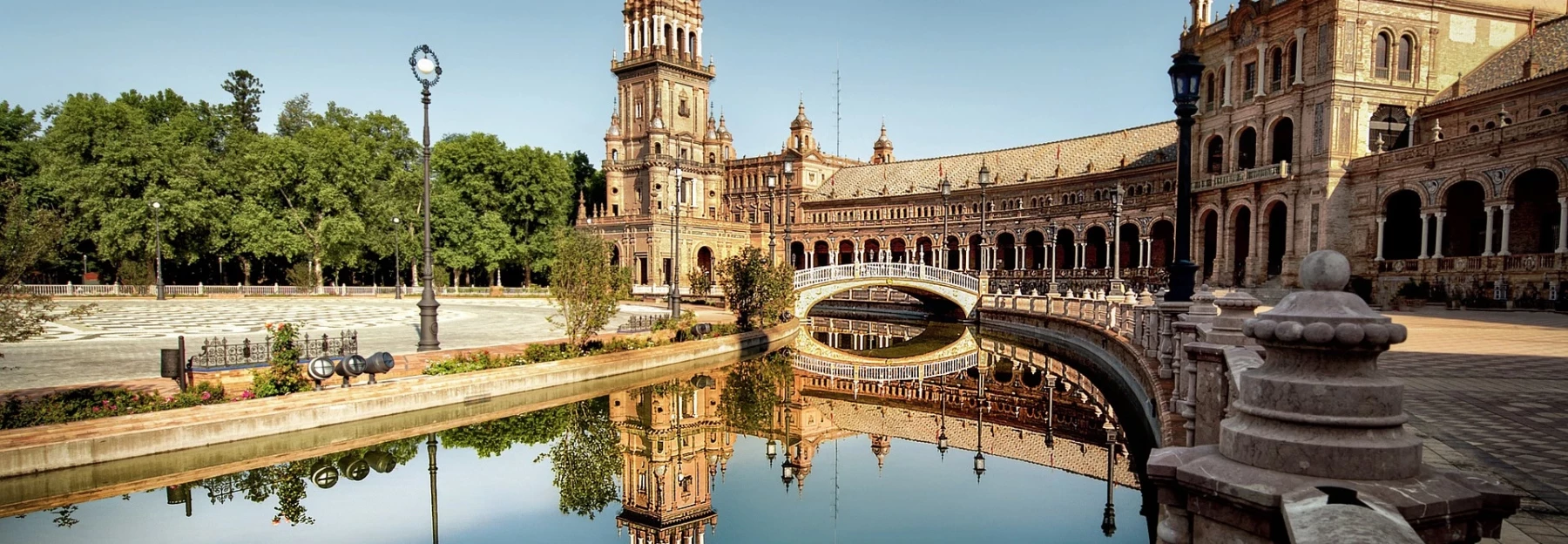To visit - Seville
Seville, also known as Sevilla in Spanish, is the capital city of the Andalusia region in southern Spain. It's renowned for its rich history, stunning architecture, vibrant culture, and delicious cuisine. Here are some key highlights about Seville:
-
Architecture: Seville boasts a diverse array of architectural styles spanning centuries, from its Moorish heritage to Renaissance, Baroque, and Gothic influences. The most famous example of Moorish architecture is the Alcázar of Seville, a stunning palace complex with beautiful gardens. The Cathedral of Seville, a UNESCO World Heritage Site, is another iconic landmark, renowned for its Gothic architecture and the Giralda, a bell tower originally built as a minaret.
-
Culture and Festivals: Seville is known for its lively atmosphere and festive spirit. The city hosts numerous festivals throughout the year, including the famous Feria de Abril (April Fair), a week-long celebration featuring flamenco dancing, music, and bullfighting. Semana Santa (Holy Week) is another major event, marked by processions, religious rituals, and elaborate floats.
-
Flamenco: Seville is considered one of the birthplaces of flamenco, a passionate and expressive form of Spanish music and dance. Visitors can experience authentic flamenco performances in tablaos (flamenco venues) throughout the city.
-
Cuisine: Seville offers a rich culinary scene, with a focus on traditional Andalusian cuisine. Highlights include tapas, small dishes perfect for sharing, featuring local specialties such as gazpacho (cold tomato soup), fried fish, and jamón ibérico (cured ham). Seville's streets are lined with tapas bars and restaurants where visitors can sample these delicious dishes.
-
History and Heritage: Seville has a fascinating history that dates back over two millennia. It was an important city during the Roman and Moorish periods and later became a center of exploration and trade during the Age of Discovery. The city's historic center is filled with narrow winding streets, historic buildings, and charming plazas, offering glimpses into its storied past.
Overall, Seville is a captivating destination that combines stunning architecture, rich history, vibrant culture, and delicious cuisine, making it a must-visit city in Spain.
The 15 essential things to do in Seville :
Summary
- To visit
-
- 1 - Visit Seville Cathedral and the Giralda
- 2 - Discover the Alcazar of Seville
- 3 - Visit the Plaza de España
- 4 - Stroll through the Santa Cruz neighborhood
- 5 - Visit the Real Maestranza bullring
- 6 - The Golden Tower
- 7 - The Metropol Parasol
- 8 - La Casa de Pilatos
- 9 - Walk along the Guadalquivir River
- 10 - The Triana district
- 11 - La Casa de la Memoria
- 12 - The Arab baths Aire de Sevilla
- 13 - Maria Luisa Park
- 14 - Lebrija Palace
- 15 - Take a day trip to Cordoba or Granada
- Seville - Where to Stay?
- Seville - How to get around?
- Seville - Best period
1 - Visit Seville Cathedral and the Giralda
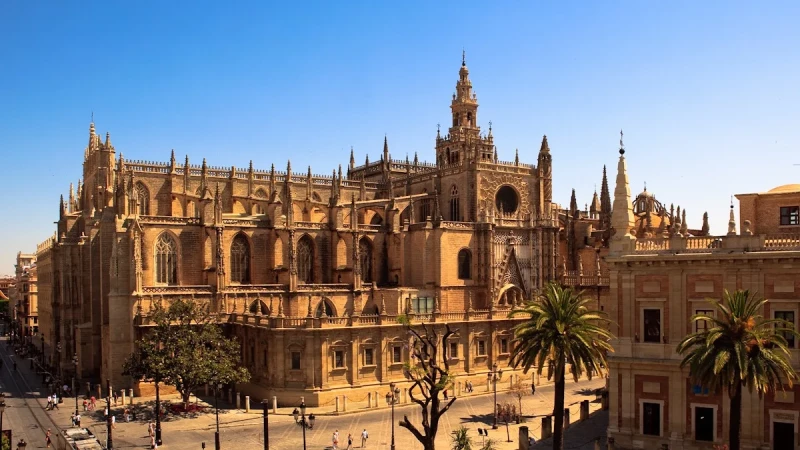
The Seville Cathedral is one of the largest Gothic cathedrals in the world and is located in the city of Seville, Spain. It was built in the 15th century on the site of a medieval mosque. The cathedral is famous for its large size, impressive architecture, and numerous religious artworks.
The Giralda is the iconic bell tower of the Seville Cathedral. Originally built as a minaret for the great Almohad mosque that stood at this location, the Giralda became the cathedral's bell tower after the Christian Reconquest of Spain. It is famous for its elegant Moorish architecture, intricate ornamentation, and spiral staircase that leads to the top, offering breathtaking views of the city of Seville.
Together, the Seville Cathedral and the Giralda represent a fascinating blend of architectural styles, reflecting Seville's rich and complex history as a cultural crossroads between Islam and Christianity. These iconic monuments attract millions of visitors from around the world each year.
 Our tips for getting the most out of your experience.
Our tips for getting the most out of your experience.
Visiting the Seville Cathedral and the Giralda can be an incredible experience. Here are some tips to make the most of your visit:
-
Buy tickets in advance: The Seville Cathedral is a popular attraction and can have long queues, especially during peak tourist seasons. Purchasing tickets online in advance can save you time and ensure you get access to the cathedral and the Giralda without waiting in line.
-
Visit early in the day: To avoid crowds, try to visit early in the morning when the cathedral first opens. This will give you a chance to explore the interior of the cathedral and climb the Giralda with fewer people around.
-
Dress appropriately: Remember that the Seville Cathedral is a religious site, so dress modestly. Avoid wearing shorts, sleeveless tops, or revealing clothing. It's also a good idea to wear comfortable shoes as you'll be walking and climbing stairs.
-
Take a guided tour: Consider taking a guided tour of the cathedral and the Giralda. A knowledgeable guide can provide you with historical insights, point out significant artworks and architectural features, and make your visit more enriching.
-
Climb the Giralda: Don't miss the opportunity to climb the Giralda tower for panoramic views of Seville. Pace yourself as you ascend the tower's ramped walkway, which was designed for horses, and enjoy the stunning vistas from the top.
-
Explore the interior: Take your time to explore the interior of the cathedral, which is adorned with beautiful altarpieces, sculptures, and stained glass windows. Be sure to visit the tomb of Christopher Columbus, located near the main entrance.
-
Respect the rules: Follow the rules and regulations of the cathedral, including photography restrictions and maintaining silence in certain areas. This ensures a respectful and enjoyable experience for all visitors.
By following these tips, you can have a memorable and rewarding visit to the Seville Cathedral and the Giralda.
2 - Discover the Alcazar of Seville
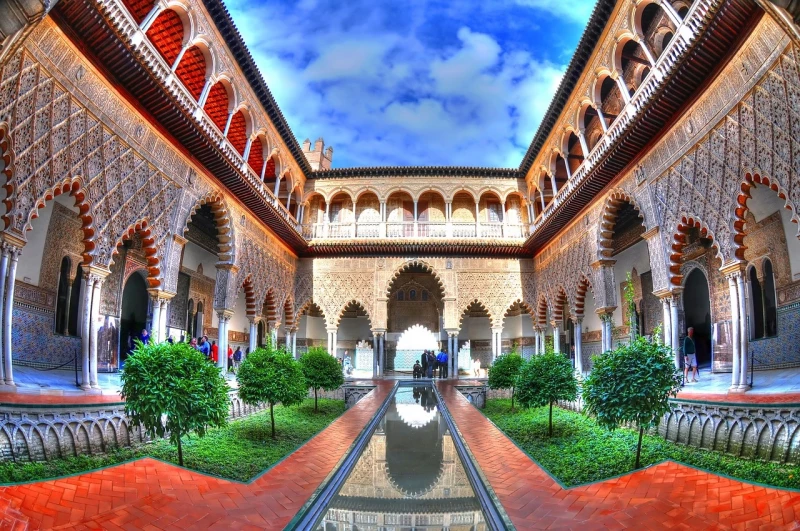
The Alcazar of Seville, also known as the Real Alcázar de Sevilla, is a fortified palace located in Seville, Spain. It is remarkable for its unique blend of architectural styles, resulting from several expansions and renovations carried out over the centuries.
The Alcazar was initially built in 913 by order of the caliph Abd al-Rahman III. Since then, it has undergone numerous modifications and additions by successive rulers, including the Almohads, the Almoravids, the Taifas, and the Catholic kings. This long history of development has resulted in an impressive palatial complex characterized by Islamic, Gothic, Mudéjar, Renaissance, and Baroque architectural elements.
The palace is surrounded by magnificent gardens, with the Moorish-style gardens being particularly famous for their fountains, shaded courtyards, and floral motifs. These gardens provide a tranquil space for strolling and relaxation, offering a pleasant contrast to the opulence of the palace itself.
The Alcazar of Seville has been inscribed on UNESCO's World Heritage List since 1987 in recognition of its outstanding cultural and architectural significance. It remains one of Seville's most popular tourist attractions, drawing visitors from around the world to experience its fascinating history and remarkable beauty.
 Our tips for getting the most out of your experience.
Our tips for getting the most out of your experience.
Discovering the Alcazar of Seville can be a wonderful experience, as it's one of the most iconic landmarks in the city, boasting a fascinating history and stunning architecture. Here are some tips to make the most of your visit:
-
Book your tickets in advance: The Alcazar is a very popular attraction, especially during tourist seasons. To avoid long queues, it's recommended to book your tickets online in advance.
-
Choose the right time of day: Try to visit early in the morning or late in the afternoon to avoid crowds. This will also allow you to enjoy the beauty of the Alcazar in a more peaceful atmosphere.
-
Take a guided tour: For a more enriching experience, consider taking a guided tour. Guides can provide in-depth historical and cultural information about the Alcazar, helping you to better appreciate your visit.
-
Explore the gardens: The Alcazar is famous not only for its architecture but also for its magnificent gardens. Take the time to explore the various gardens, such as the Garden of the Dance or the Garden of the Fish, which offer breathtaking landscapes.
-
Admire the architectural details: The Alcazar is a masterpiece of Moorish and Mudejar architecture. Take the time to admire the intricate details of the ceilings, azulejos (decorated ceramic tiles), and fountains, which showcase the craftsmanship and expertise of the time.
-
Visit the different rooms and courtyards: The Alcazar is comprised of several rooms and courtyards, each with its own charm and history. Explore them all to discover the richness of this monument.
-
Respect the visiting rules: Like any tourist attraction, it's important to respect the visiting rules of the Alcazar, such as photography regulations and respectful behavior towards other visitors and the site itself.
By following these tips, you'll be able to fully enjoy your visit to the Alcazar of Seville and learn more about its history and architectural beauty.
3 - Visit the Plaza de España
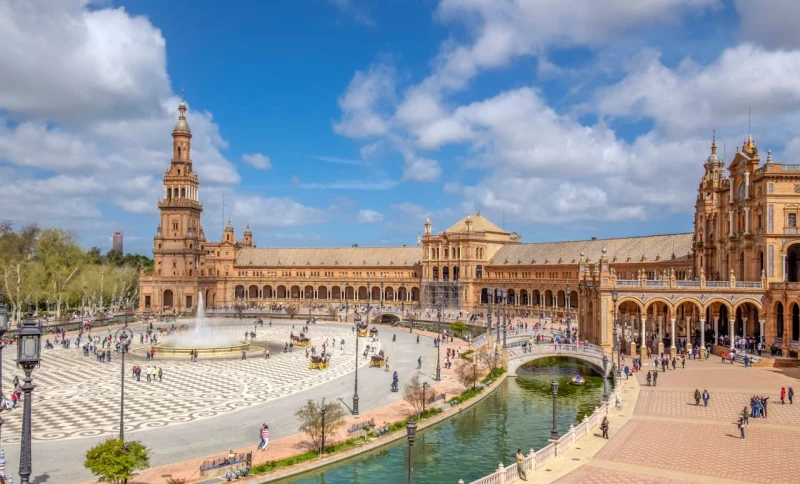
The Plaza de España is one of the most iconic landmarks in the city of Seville, Spain. It was built for the Ibero-American Exposition of 1929, designed by architect Aníbal González. This square is an impressive example of Andalusian regionalist architecture, combining elements of Renaissance and Baroque styles.
The plaza has a semicircular shape and is bordered by a monumental building with ceramic benches along its perimeter, representing the provinces of Spain. It also features a canal that runs along its perimeter, where small boats can be rented for paddling. In the center of the square, there is a fountain.
The Plaza de España is a very popular spot for tourists and locals alike and is often used as a venue for cultural events and festivals. It's an ideal place for strolling, admiring the architecture, taking photos, and relaxing in one of the city's largest parks.
4 - Stroll through the Santa Cruz neighborhood
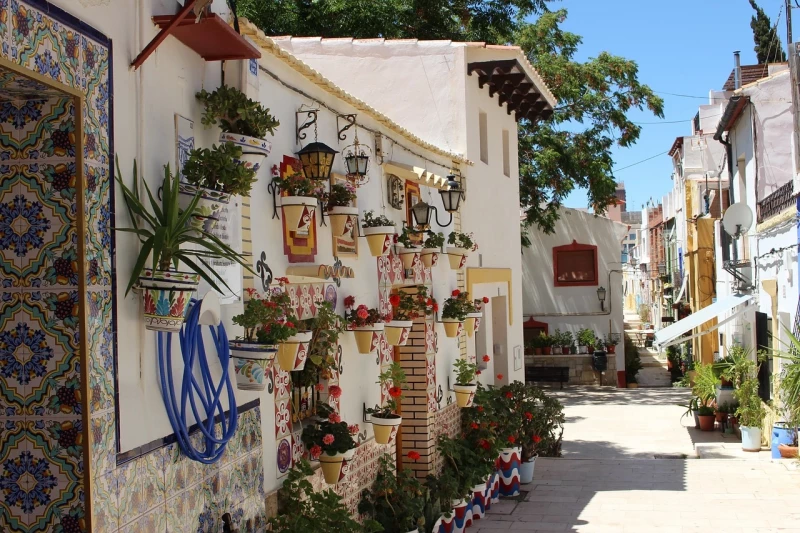
Strolling through the Santa Cruz neighborhood in Seville is a delightful and enchanting experience. This historic quarter is famous for its narrow winding streets, flower-filled patios, lively squares, and bohemian atmosphere. Here are some things you might enjoy while wandering through this neighborhood:
-
Picturesque alleys: Lose yourself in the narrow winding streets of Santa Cruz, where every corner reveals new charm. Colorful facades, flower-filled balconies, and small squares invite exploration.
-
Hidden patios: Santa Cruz is famous for its inner courtyards, often hidden behind discreet doors. These tranquil spaces are often adorned with lush plants and fountains, offering a refreshing break from the bustle of the streets.
-
Lively squares: Places like Plaza de Santa Cruz or Plaza de los Venerables provide the opportunity to sit and relax while observing local life. You might also find street performers and musicians adding to the vibrant atmosphere.
-
Artisan shops: Santa Cruz is full of small craft shops where you can find ceramics, jewelry, textiles, and other unique souvenirs to take home.
-
Local cuisine: Don't miss the chance to taste delicious Andalusian cuisine at one of the many tapas bars or restaurants in Santa Cruz. Delicious specialties such as gazpacho, salmorejo, croquettes, and churros await.
By strolling through the Santa Cruz neighborhood, you'll discover the very essence of Seville: its rich history, vibrant culture, and timeless charm.
5 - Visit the Real Maestranza bullring
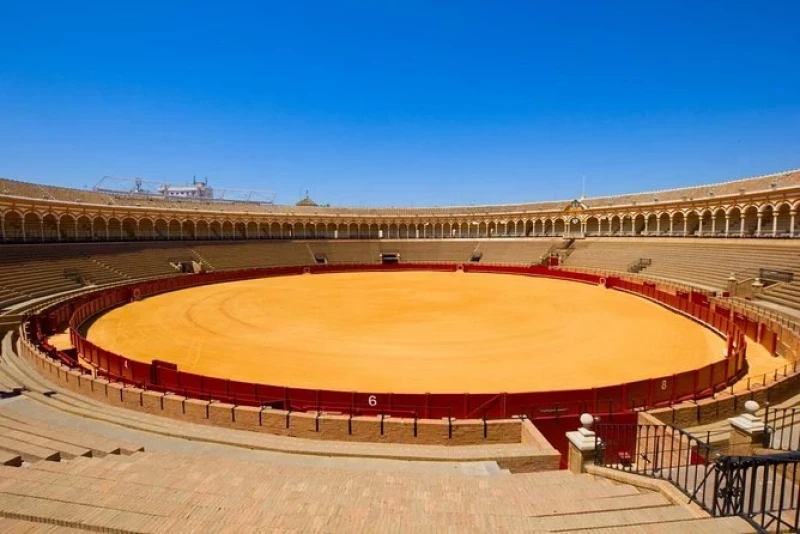
The Real Maestranza bullring in Seville is one of the most iconic and historic bullfighting arenas in Spain. Located in the heart of the city's historic center, near the river Guadalquivir, it's a significant cultural landmark and a must-visit for those interested in Spanish bullfighting traditions.
Here are some key points about the Real Maestranza bullring:
-
History: The Real Maestranza de Caballería de Sevilla, founded in 1670, is the organization responsible for managing the bullring. The current arena, known as the Plaza de Toros de la Real Maestranza, was built between 1749 and 1881, making it one of the oldest bullrings in Spain.
-
Architecture: The bullring's architecture is typical of the Andalusian Baroque style, with its distinctive horseshoe-shaped arena and rows of seating tiers. The façade features ornate decorations and intricate ironwork, adding to its grandeur.
-
Bullfighting: The Real Maestranza is renowned for hosting some of the most prestigious bullfights in Spain, particularly during the annual Feria de Abril (April Fair). Bullfighting season typically runs from spring to autumn, with corridas (bullfights) taking place regularly.
-
Museum: Within the bullring complex, there's a museum dedicated to bullfighting, showcasing the history, art, and culture of this traditional Spanish spectacle. Visitors can learn about the different aspects of bullfighting, including the costumes, equipment, and the role of the matador.
-
Tours: Guided tours of the bullring are available, providing visitors with insights into its history, architecture, and the rituals of bullfighting. These tours often include access to the arena, the bullfighters' chapel, and the bullpens.
-
Cultural significance: Bullfighting is a deeply ingrained tradition in Spanish culture, and the Real Maestranza bullring plays a central role in preserving and promoting this cultural heritage. However, it's worth noting that bullfighting is a controversial practice, and opinions about it vary widely.
Visiting the Real Maestranza bullring offers a fascinating glimpse into Spain's bullfighting tradition, its history, and its cultural significance. Whether you're a supporter or a critic of bullfighting, experiencing this iconic arena provides valuable insights into Spanish culture and traditions.
6 - The Golden Tower
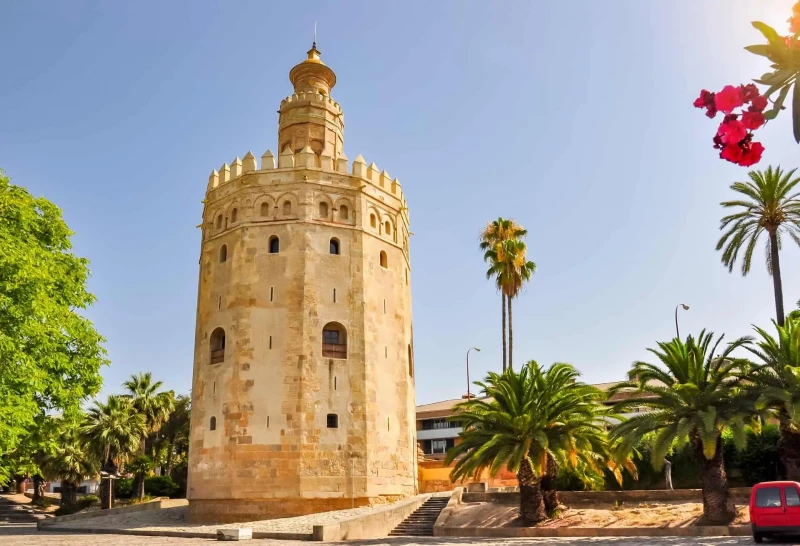
The Torre del Oro is a military tower located in the city of Seville, Spain, on the banks of the Guadalquivir River. Its name, which translates to "Tower of Gold" in English, comes from the golden glow that the tiles on its facade reflected onto the river and the city. The tower was built in the 13th century during the Almohad rule in the region, with the purpose of controlling maritime access to the city.
The Torre del Oro has an octagonal shape and was originally part of the fortifications that protected the entrance to the port of Seville. Over the years, it has served various functions, ranging from a watchtower and defense post to being used as a prison during certain periods of history.
Currently, the Torre del Oro houses the Naval Museum of Seville, showcasing exhibitions related to the maritime history of the city and the significance of the Guadalquivir River in the region's development. Additionally, it offers visitors stunning panoramic views of Seville from its lookout point. The Torre del Oro is one of the iconic landmarks of the city, drawing numerous tourists each year.
7 - The Metropol Parasol
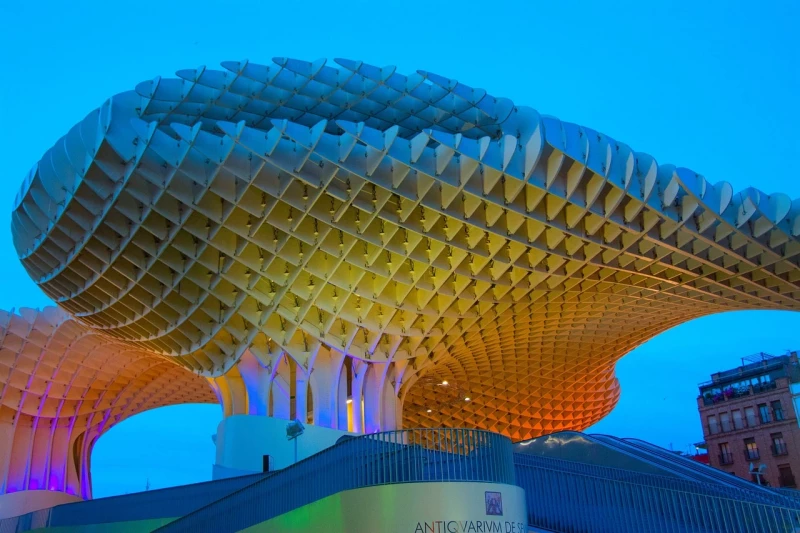
The Metropol Parasol is a modern architectural structure located in Seville, Spain. It is also known as "Las Setas" (The Mushrooms) due to its design resembling wooden parasols. This impressive structure was designed by the German architect Jürgen Mayer and was completed in 2011.
Situated on the Plaza de la Encarnación in the heart of Seville, the Metropol Parasol consists of six wavy-shaped wooden parasols supported by steel pillars. These parasols provide shade for visitors and house various public spaces, including restaurants, shops, and a market. The bold and contemporary design of the Metropol Parasol contrasts sharply with Seville's historic architecture, but it has become a popular attraction in the city.
The structure also offers panoramic views of Seville from its top, making it a favorite spot for tourists. The Metropol Parasol is often considered one of Seville's most iconic modern structures and has contributed to the revitalization of the area where it is located.
8 - La Casa de Pilatos
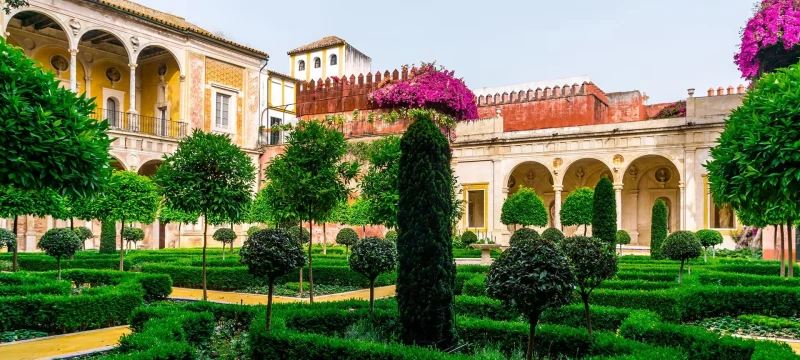
The Casa de Pilatos, located in Seville, Spain, is a 16th-century Andalusian palace that blends various architectural styles, including Mudéjar, Gothic, Renaissance, and Baroque. It is considered one of the most remarkable examples of Sevillian architecture.
Here are some key points about the Casa de Pilatos:
-
History: Construction of the Casa de Pilatos began in the 15th century, but much of its current architecture dates back to the 16th century. The palace was built for the Enríquez family but was later inherited by the ducal family of Medinaceli.
-
Architecture: The Casa de Pilatos features a unique combination of architectural styles. It includes a central courtyard, gardens, galleries, courtyards, fountains, and a chapel. The amalgamation of styles reflects influences from different construction periods.
-
Visits: The Casa de Pilatos is open to the public, allowing visitors to explore its lavishly decorated rooms, elegant courtyards, and peaceful gardens. Guided tours are often available to provide additional historical and architectural insights.
-
Main Courtyard: The main courtyard is one of the most impressive features of the Casa de Pilatos. It is surrounded by arcades with ornate ceramic tiles, sculptures, and elaborate architectural details.
-
Chapel: The palace's chapel is dedicated to the Flagellation of Christ (La Flagelación). It features rich decoration, carved altars, and religious artworks.
-
Gardens: The gardens of the Casa de Pilatos offer a tranquil escape with pathways, fountains, and statues. They exemplify the influence of Andalusian gardens.
-
Cultural Events: Occasionally, the Casa de Pilatos hosts cultural events such as concerts, exhibitions, and artistic activities.
The Casa de Pilatos is an important cultural and historical site in Seville, providing visitors with an immersive experience in Spain's architecture and history. Before visiting, it may be helpful to check the opening hours and availability of guided tours.
9 - Walk along the Guadalquivir River
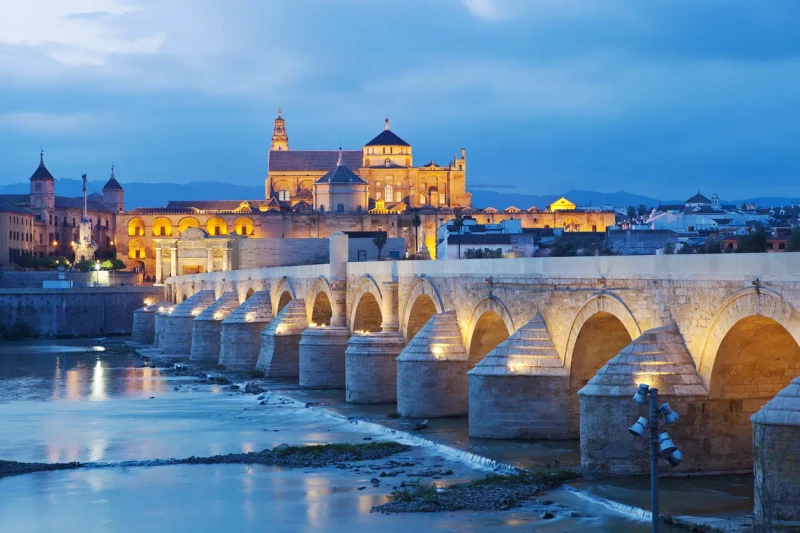
Strolling along the Guadalquivir River in Seville is a delightful experience that provides a unique perspective on the city. Here are some points to consider for a walk along the Guadalquivir:
-
Iconic Bridges: The Guadalquivir is crossed by several iconic bridges in Seville, such as the Puente de Triana and the Puente de Isabel II. These bridges offer stunning views of the river and the city.
-
Riverfront Pathways: There are pathways along the river, perfect for a leisurely stroll or bike ride. These walks allow visitors to enjoy the riverside scenery while relaxing.
-
Views of the Torre del Oro: While walking along the Guadalquivir, you'll have a beautiful view of the famous Torre del Oro, a historic military tower that adds a touch of history to the panorama.
-
Maria Luisa Park: Near the river, you'll find Maria Luisa Park, one of the largest and most picturesque parks in Seville. It's an ideal spot to relax, have a picnic, or simply enjoy nature.
-
River Cruise: For a different experience, consider taking a river cruise on the Guadalquivir. This allows you to see the city from the water and appreciate its landmarks from a unique perspective.
-
Water Activities: If you're interested in water activities, it may be possible to go kayaking or paddleboarding along the Guadalquivir, providing a different view of the city.
-
Sunsets: Evening walks along the Guadalquivir offer magnificent sunsets over Seville. The warm colors reflecting on the water create a romantic atmosphere.
-
Gastronomic Stops: Enjoy the cafes, restaurants, and bars along the river. Some establishments offer terraces with breathtaking views, perfect for savoring local cuisine while admiring the scenery.
Strolling along the Guadalquivir in Seville combines a unique blend of urban and natural landscapes, allowing visitors to discover the city's history and culture in a relaxed manner.
10 - The Triana district
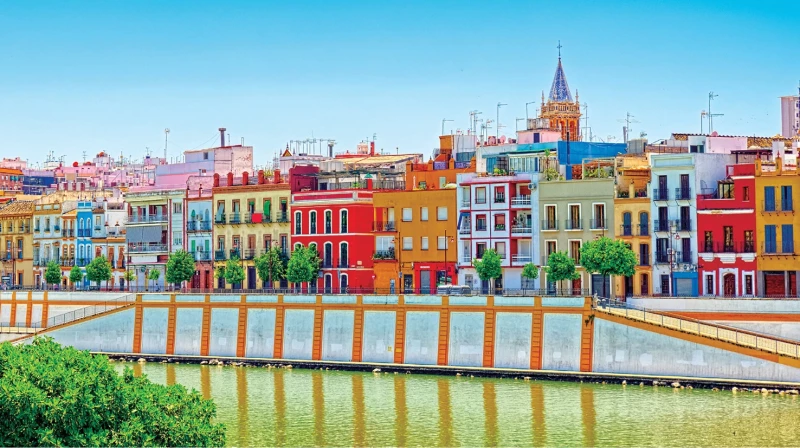
The neighborhood of Triana in Seville is one of the most iconic and traditional districts of the city. Situated on the west bank of the Guadalquivir River, Triana is famous for its lively atmosphere, narrow streets, colorful houses, artisan pottery, and flamenco heritage.
Triana has a rich and complex history. For centuries, it was a working-class and industrial neighborhood, housing pottery workshops, foundries, and shipyards. Nowadays, while many aspects of this industrial history have faded, Triana still retains its distinctive character and unique identity.
The neighborhood is filled with points of interest, including the renowned Triana Market, where you can purchase fresh local produce, ceramics, and souvenirs. There are also numerous tapas bars, restaurants, and taverns where you can indulge in traditional Sevillian cuisine.
The Triana Bridge, also known as the Isabel II Bridge, connects Triana to Seville's historic center. From there, you can enjoy stunning views of the city and the river.
Triana is also associated with the art of flamenco. There are several bars and flamenco tablaos where you can witness authentic flamenco dance and music performances.
In summary, the neighborhood of Triana is a must-visit for anyone exploring Seville, offering a unique experience steeped in history, culture, and Andalusian tradition.
11 - La Casa de la Memoria
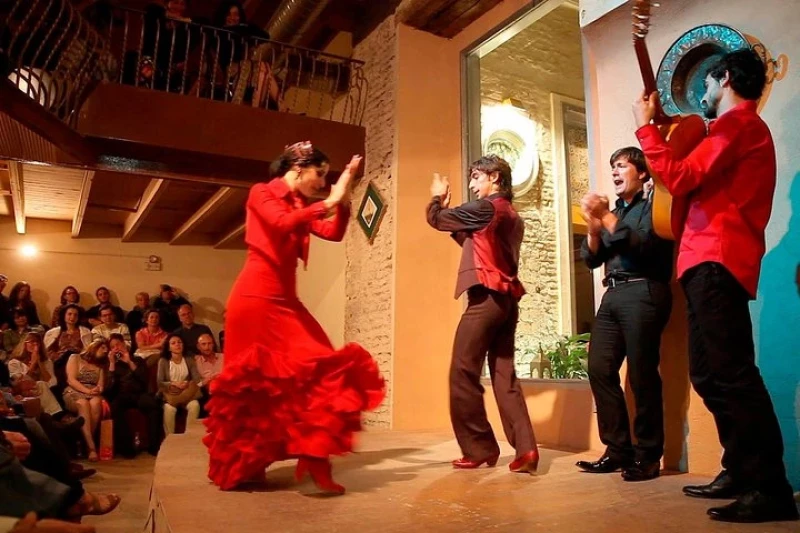
La Casa de la Memoria is a renowned flamenco tablao located in the Santa Cruz neighborhood of Seville, Spain. Established in 1999, this flamenco house is known for its high-quality flamenco dance and music performances.
La Casa de la Memoria offers daily shows featuring some of the best flamenco artists in Seville. The performances take place in an intimate and authentic setting, providing audiences with an immersive experience of flamenco art.
In addition to regular shows, La Casa de la Memoria also hosts exhibitions of flamenco photography and art, as well as special events showcasing the richness of flamenco culture.
For flamenco enthusiasts or those looking to experience this iconic art form of Andalusia, La Casa de la Memoria is a must-visit venue in Seville.
12 - The Arab baths Aire de Sevilla
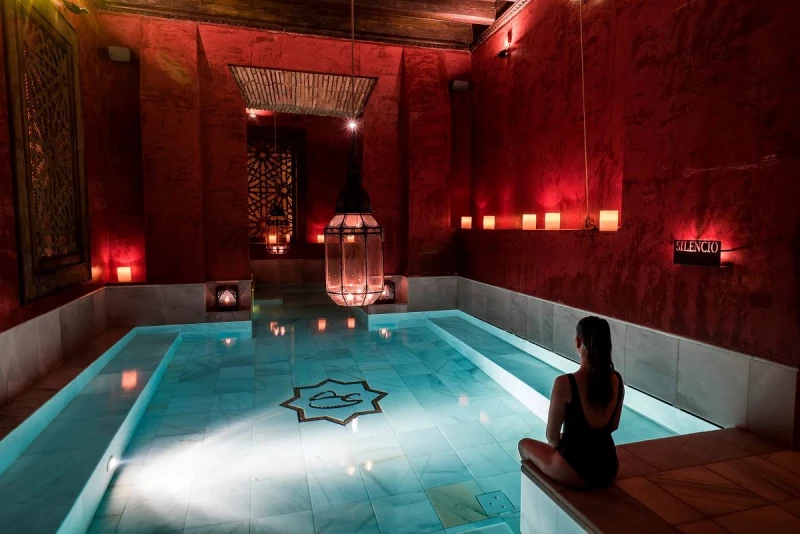
Aire de Sevilla Arab Baths is a luxurious spa located in the heart of Seville, Spain. This facility offers visitors a unique and relaxing experience inspired by the ancient tradition of Arab baths.
The baths are designed to evoke the ambiance of traditional Moorish baths, featuring beautiful architecture, soothing music, and aromatic scents. Visitors can indulge in a variety of spa treatments and experiences, including hot baths, cold baths, steam rooms, and massages.
Aire de Sevilla provides a serene and tranquil environment where guests can unwind and rejuvenate both body and mind. It's a perfect escape from the hustle and bustle of city life, allowing visitors to immerse themselves in a world of relaxation and pampering.
Whether you're looking to treat yourself to a luxurious spa day or simply seeking a peaceful retreat, Aire de Sevilla Arab Baths offers an unforgettable experience steeped in history and tranquility.
 Our tips for getting the most out of your experience.
Our tips for getting the most out of your experience.
If you're planning to visit the Aire de Sevilla Arab Baths, here are some tips to make the most of your experience:
-
Book in advance: The baths can be quite popular, especially during peak tourist seasons, so make sure to book your tickets in advance to secure your preferred time slot.
-
Choose the right time: Try to visit the Arab baths during off-peak hours to avoid crowds and enjoy a more peaceful and relaxing experience.
-
Opt for an extra treatment: In addition to access to the various pools and steam rooms, consider booking a massage or another treatment to complement your relaxation experience.
-
Bring essential items: Make sure to bring a swimsuit, flip-flops, and a towel. Some establishments provide towels, but it's always good to have your own.
-
Respect rules and customs: Arab baths have their own rules and customs. Be sure to follow the staff's guidelines and maintain a calm and respectful atmosphere.
-
Stay hydrated: It's important to stay hydrated during your visit to the baths. Be sure to drink plenty of water to avoid dehydration, especially if you're using heat facilities like steam rooms.
-
Relax: Take the opportunity to relax and unwind. Take your time to explore the different pools and steam rooms, and let yourself be carried away by the soothing atmosphere of the Arab baths.
By following these tips, you're sure to have an enjoyable and relaxing time at the Aire de Sevilla Arab Baths.
13 - Maria Luisa Park
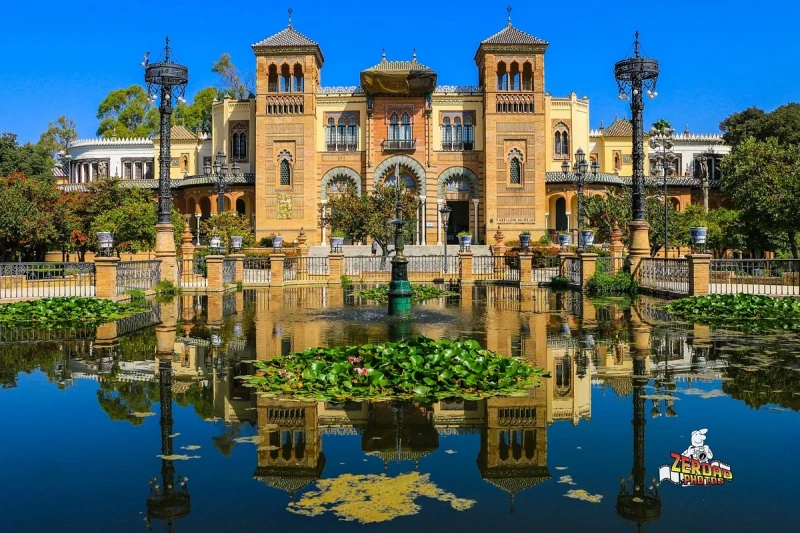
The Parque de María Luisa, located in Seville, Spain, is one of the most beautiful parks in the city and one of the most famous in Spain. This spacious and picturesque park is a green oasis in the heart of the city, providing residents and visitors alike with a tranquil retreat away from the urban hustle and bustle.
The park is named after the Spanish infanta María Luisa Fernanda de Bourbon, Duchess of Montpensier, who donated the park to the city of Seville in 1893. It was landscaped for the Ibero-American Exposition of 1929, which contributed to its international renown.
The Parque de María Luisa is notable for its extensive landscaped gardens, shaded walkways, fountains, and picturesque ponds. Visitors can stroll along winding paths, admire beautiful flower beds, or relax in the shade of the numerous exotic and native trees.
One of the park's most iconic features is the Plaza de España, a monumental square built in a neo-Moorish style, which is bordered by a half-circle of impressive buildings adorned with colorful ceramic tiles. This majestic square is often used as a filming location for movies and TV series due to its beauty and remarkable architecture.
In addition to the Plaza de España, the park is home to many other monuments, statues, and historic landmarks, making every stroll a culturally enriching experience.
The Parque de María Luisa is a beloved spot for locals and tourists alike, offering a haven of peace and beauty in the heart of Seville. Whether for a leisurely walk, a photo shoot, or simply to enjoy nature, this magnificent park is a must-visit when in Seville.
14 - Lebrija Palace
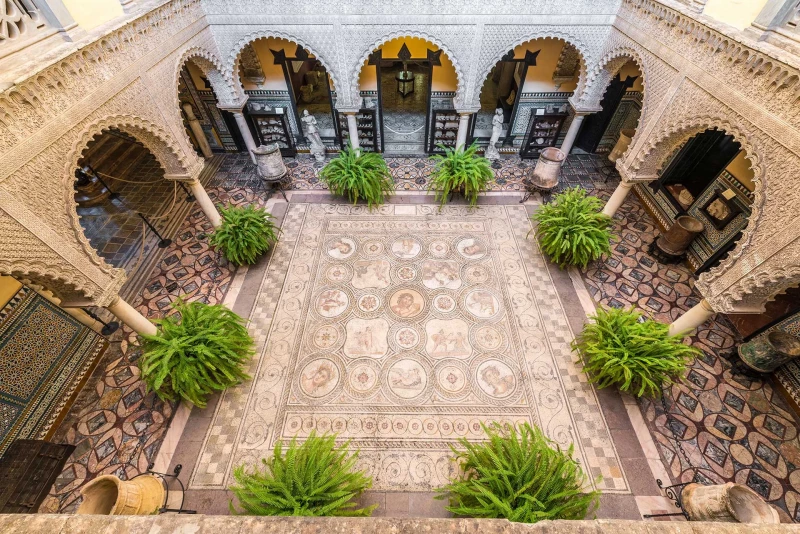
The Palace of Lebrija, located in Seville, Spain, is a remarkable example of a historic mansion with an impressive collection of Roman mosaics. This palace, also known as the Palacio de la Condesa de Lebrija, is renowned for its stunning architecture, intricate tilework, and rich history.
Built in the 16th century, the Palace of Lebrija was originally a noble residence. It underwent significant renovations in the late 19th and early 20th centuries under the ownership of the Countess of Lebrija, who transformed it into a showcase of art and culture.
One of the palace's most striking features is its extensive collection of Roman mosaics, which are among the best-preserved in Spain. These mosaics, dating back to the 2nd and 3rd centuries AD, decorate the floors of several rooms and depict various mythological and historical scenes.
In addition to its impressive mosaics, the Palace of Lebrija boasts beautiful architectural details, including intricately carved wooden ceilings, elegant marble columns, and elaborately decorated tiles. The palace's rooms are furnished with antique furniture, paintings, and other decorative arts, providing visitors with a glimpse into the opulent lifestyle of Seville's aristocracy.
Today, the Palace of Lebrija is open to the public as a museum, allowing visitors to explore its rich history and admire its exquisite art and architecture. It is a must-visit destination for anyone interested in history, art, and culture while in Seville.
15 - Take a day trip to Cordoba or Granada
Taking a day trip to Cordoba or Granada from Seville is a fantastic way to explore more of Andalusia and its historical treasures. Here are some highlights to consider for each destination:
Day Trip to Cordoba from Seville:
- The Mosque-Cathedral (Mezquita-Catedral): One of Spain's most famous landmarks, this mosque-cathedral is a striking example of Islamic and Christian architecture.
- The Jewish Quarter (Judería): Wander through the narrow, picturesque streets of this historic neighborhood filled with flower-filled patios, craft shops, and charming cafes.
- The Roman Bridge (Puente Romano): Enjoy panoramic views of the Guadalquivir River as you cross this iconic bridge, dating back to Roman times.
- Cordovan Patios: Admire Cordoba's famous patios, which are UNESCO World Heritage Sites for their beauty and tradition.
Day Trip to Granada from Seville:
- The Alhambra and the Generalife: Visit this famous Moorish fortress with its sumptuous palaces, lush gardens, and breathtaking views of the city.
- The Albaicín Quarter: Get lost in the winding streets of this medieval neighborhood, steeped in Granada's Muslim history, and enjoy its charming cafes and craft shops.
- Mirador de San Nicolás: Take in a breathtaking panoramic view of the Alhambra and the Sierra Nevada mountains from this viewpoint in the Albaicín.
- Granada City Center: Experience Granada's lively atmosphere by strolling through its shopping streets, tasting tapas in its typical bars, and visiting its many historical landmarks.
Whether you choose to visit Cordoba or Granada from Seville, you're guaranteed to have an enriching and memorable experience steeped in the history and culture of Andalusia. Make sure to plan your excursion based on your personal preferences and the time available to fully enjoy each destination.
Seville - Where to Stay?
To choose accommodation in Seville, you have several options depending on your budget, preferences, and the experience you're seeking. Here are some suggestions:
-
Historic Center (Casco Antiguo): Seville has a beautiful historic center, where you'll find numerous monuments, restaurants, shops, and tourist attractions. Staying in this area will put you right in the heart of the action and allow you to easily explore the city on foot. There's a variety of accommodation options available, from luxury hotels to budget-friendly hostels.
-
Triana: This traditional neighborhood of Seville, located on the other side of the Guadalquivir River, offers an authentic atmosphere with its picturesque streets, lively taverns, and covered market. It's a great choice if you're looking for a more local and less touristy experience while still being close to the city center.
-
Alameda de Hércules: This bustling area is known for its vibrant nightlife, trendy restaurants, and tapas bars. It's situated slightly outside the historic center but remains easily accessible on foot or by public transportation. It's a good option if you enjoy being close to the action and nighttime entertainment.
-
Santa Cruz: This neighborhood, once the Jewish quarter of Seville, is famous for its charming narrow streets, flower-filled patios, and lively squares. It's a romantic and picturesque place to stay, with many charming hotels and guesthouses.
-
Nervión: If you prefer a more modern environment and affordable accommodation options, you might consider staying in the Nervión district. This area is also well-connected by public transportation, making it easy to travel to other parts of the city.
Whichever neighborhood you choose, be sure to book your accommodation in advance, especially during peak tourist seasons like Holy Week or the Feria de Abril, to secure the best rates and available options.
Seville - How to get around?
Getting around Seville is relatively easy thanks to a well-developed public transportation network and the option to walk in many parts of the city. Here are some options for getting around Seville:
-
Walking: The historic center of Seville is compact and perfect for walking. You can explore major attractions such as the Cathedral, the Alcazar, and the Santa Cruz neighborhood on foot. It's also a great way to discover the charming narrow streets and lively squares of the city.
-
Cycling: Seville has an extensive network of bike lanes, making it a pleasant city to explore by bike. You can rent bikes at many rental shops or use the bike-sharing system called Sevici, which offers bike stations throughout the city.
-
Public Transportation: Seville has an efficient bus network operated by Tussam. Buses serve all parts of the city, including suburbs and outlying areas. There's also a tram system that connects some neighborhoods. Tickets can be purchased onboard buses or at tram stations.
-
Metro: Seville has a light rail metro system (Seville Metro) that connects some neighborhoods of the city. While the network is limited compared to other major cities, it can be useful for traveling quickly over longer distances.
-
Taxis and Ride-Sharing Services: Taxis are readily available throughout the city and provide a convenient way to get around, especially at night or if you have bulky luggage. Additionally, ride-sharing services like Uber and Cabify are also available in Seville.
In summary, transportation options in Seville include walking, cycling, public transportation, the metro, taxis, and ride-sharing services. You can choose the one that best suits your needs and specific itinerary during your visit to this beautiful Spanish city.
Seville - Best period
The best time to visit Seville depends on your personal preferences regarding weather, events, and tourist crowds. Here are some factors to consider when choosing the ideal time for your visit:
-
Spring (March to May): Spring is one of the most popular seasons to visit Seville. The weather is generally pleasant, with sunny days and mild temperatures, making it an ideal time for exploring the city on foot and enjoying outdoor attractions. April is particularly vibrant with the Feria de Abril, a colorful traditional festival celebrating Andalusian culture.
-
Autumn (September to November): Autumn is also a pleasant time to visit Seville. Temperatures start to cool down after the hot summer months, but generally remain comfortable for sightseeing. Additionally, you may avoid the summer crowds, especially in September and November.
-
Summer (June to August): The summer months in Seville can be very hot, with temperatures often exceeding 40 degrees Celsius (100 degrees Fahrenheit). However, if you can tolerate the heat, you might enjoy lower accommodation rates and fewer tourists. Be sure to stay hydrated and take breaks in the shade during the hottest parts of the day.
-
Winter (December to February): Winter in Seville is mild compared to many other European destinations, but temperatures can be cool, especially at night. It's an ideal time to avoid tourist crowds and take advantage of reduced accommodation rates. Christmas decorations also add a festive atmosphere to the city.
In summary, spring and autumn are generally considered the best seasons to visit Seville due to pleasant temperatures and cultural events. However, if you can handle the summer heat, you might also enjoy visiting the city in summer, while winter offers a quieter ambiance and advantageous accommodation rates.
